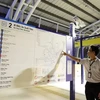In Vietnam, television remains the most powerful and effective form of mass media, with 85 per cent of the population watching TV every day, according to a report released by Kantar Media's TNS Media Vietnam.
Television is also the most common household appliance and communications vehicle in Vietnamese families with 27 percent of the population own two or more televisions and 95 percent say they respect the medium, according to the survey.
Television maintains the highest daily reach, with nearly 83 percent of people aged 15 to 54 watching TV two hours a day.
The internet's average daily reach ranks second, if compared with television, except in the Cuu Long ( Mekong ) Delta region.
However, the Mekong Delta and southeastern regions lead the country in the number of people who listen to radio and read print newspapers and magazines.
In southern provinces, the number of people who use video-players is higher than that in northern provinces .
In the past, TV aerials were used by Vietnamese households to receive broadcast television signals.
But now many families receive television signals by cable, satellite and terrestrial digital services instead. The percentage of people who use TV aerials has dropped to only 39 percent.
However, in the Mekong Delta region, 57 per cent of families use TV aerials.
The strong development of cable and digital television has enabled households to watch at least 20 TV channels.
National TV channels VTV1 and VTV3 can cover all localities nationwide. Even some local TV channels like HTV and THVL1 (the latter in southern Vinh Long Province ) can penetrate remote areas like the Central Highlands (Tay Nguyen) and northern mountainous regions.
In some localities in the Hong (Red) River Delta like Ha Noi and southeastern region like HCM City , families have access to more foreign TV channels than Vietnamese channels.
Residents in the southeastern region spend more time listening to radio, reading newspapers and using the internet, compared with other localities in the country, with the amount of time averaging 224, 44, 28 and 76 minutes, respectively.
Meanwhile, people in the Mekong Delta region lead the country in spending time watching television and using video players, with 256 and 49 minutes, respectively.
For young people, they tend to spend more time using the internet, which will likely make it a competitive media form with television in the future.
Thirty-eight percent of the young people in the southeastern region use the Internet regularly.
However, according to TNS Media Vietnam, although the use of the internet is increasing among Vietnamese, especially youth, it has not replaced television.
With the strong development of technology, mobile phones are becoming a multi-media means, threatening to rival the role of television in the future.
Up to 85 percent of the population aged 15 to 54 own mobile phones.
The percentage of people using mobiles to listen to radio and music stations and access the Internet has increased sharply every year.
Regarding the advertising area, television is still the most powerful ways to advertise in Vietnam . At least 77 percent of those polled said they like to watch advertisements on television because of both images and sounds.
TNS Media Vietnam's report, the first of its kind in the country, was based on 4,800 face-to-face interviews with people aged 15 to 54 in most localities nationwide.
The goal was to meet the rising demand of media owners, traders and producers, advertisers, and researchers.-VNA
Television is also the most common household appliance and communications vehicle in Vietnamese families with 27 percent of the population own two or more televisions and 95 percent say they respect the medium, according to the survey.
Television maintains the highest daily reach, with nearly 83 percent of people aged 15 to 54 watching TV two hours a day.
The internet's average daily reach ranks second, if compared with television, except in the Cuu Long ( Mekong ) Delta region.
However, the Mekong Delta and southeastern regions lead the country in the number of people who listen to radio and read print newspapers and magazines.
In southern provinces, the number of people who use video-players is higher than that in northern provinces .
In the past, TV aerials were used by Vietnamese households to receive broadcast television signals.
But now many families receive television signals by cable, satellite and terrestrial digital services instead. The percentage of people who use TV aerials has dropped to only 39 percent.
However, in the Mekong Delta region, 57 per cent of families use TV aerials.
The strong development of cable and digital television has enabled households to watch at least 20 TV channels.
National TV channels VTV1 and VTV3 can cover all localities nationwide. Even some local TV channels like HTV and THVL1 (the latter in southern Vinh Long Province ) can penetrate remote areas like the Central Highlands (Tay Nguyen) and northern mountainous regions.
In some localities in the Hong (Red) River Delta like Ha Noi and southeastern region like HCM City , families have access to more foreign TV channels than Vietnamese channels.
Residents in the southeastern region spend more time listening to radio, reading newspapers and using the internet, compared with other localities in the country, with the amount of time averaging 224, 44, 28 and 76 minutes, respectively.
Meanwhile, people in the Mekong Delta region lead the country in spending time watching television and using video players, with 256 and 49 minutes, respectively.
For young people, they tend to spend more time using the internet, which will likely make it a competitive media form with television in the future.
Thirty-eight percent of the young people in the southeastern region use the Internet regularly.
However, according to TNS Media Vietnam, although the use of the internet is increasing among Vietnamese, especially youth, it has not replaced television.
With the strong development of technology, mobile phones are becoming a multi-media means, threatening to rival the role of television in the future.
Up to 85 percent of the population aged 15 to 54 own mobile phones.
The percentage of people using mobiles to listen to radio and music stations and access the Internet has increased sharply every year.
Regarding the advertising area, television is still the most powerful ways to advertise in Vietnam . At least 77 percent of those polled said they like to watch advertisements on television because of both images and sounds.
TNS Media Vietnam's report, the first of its kind in the country, was based on 4,800 face-to-face interviews with people aged 15 to 54 in most localities nationwide.
The goal was to meet the rising demand of media owners, traders and producers, advertisers, and researchers.-VNA



















